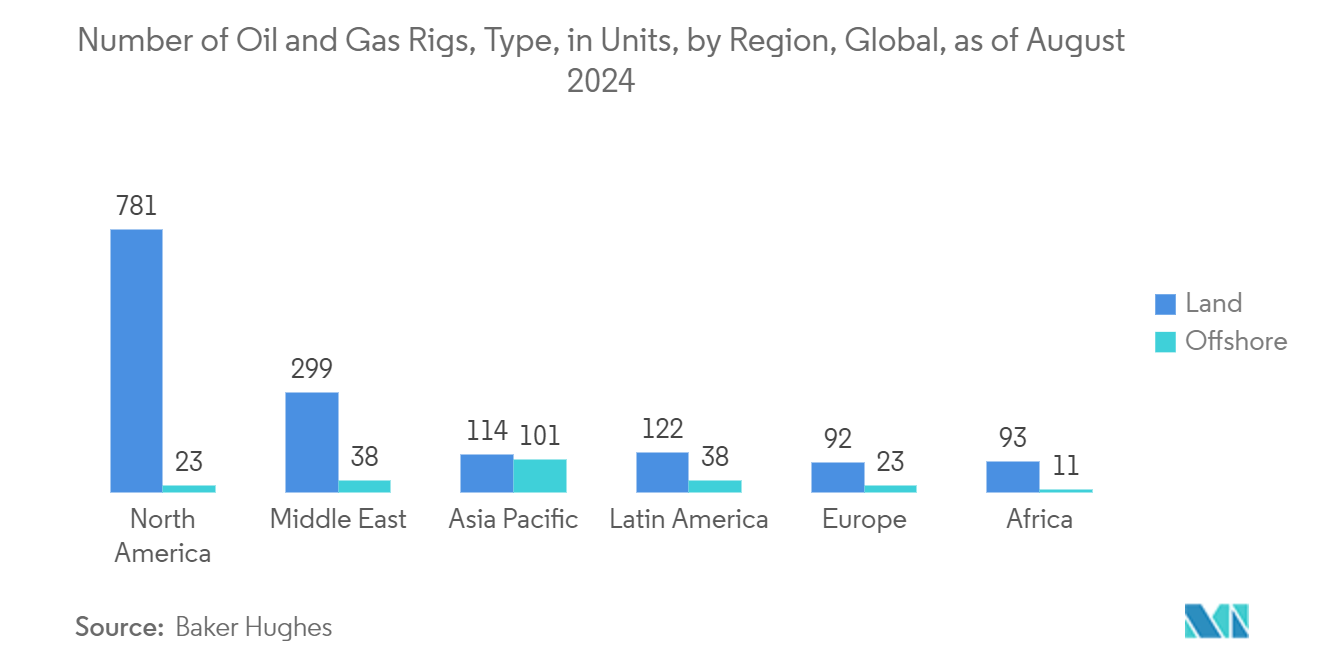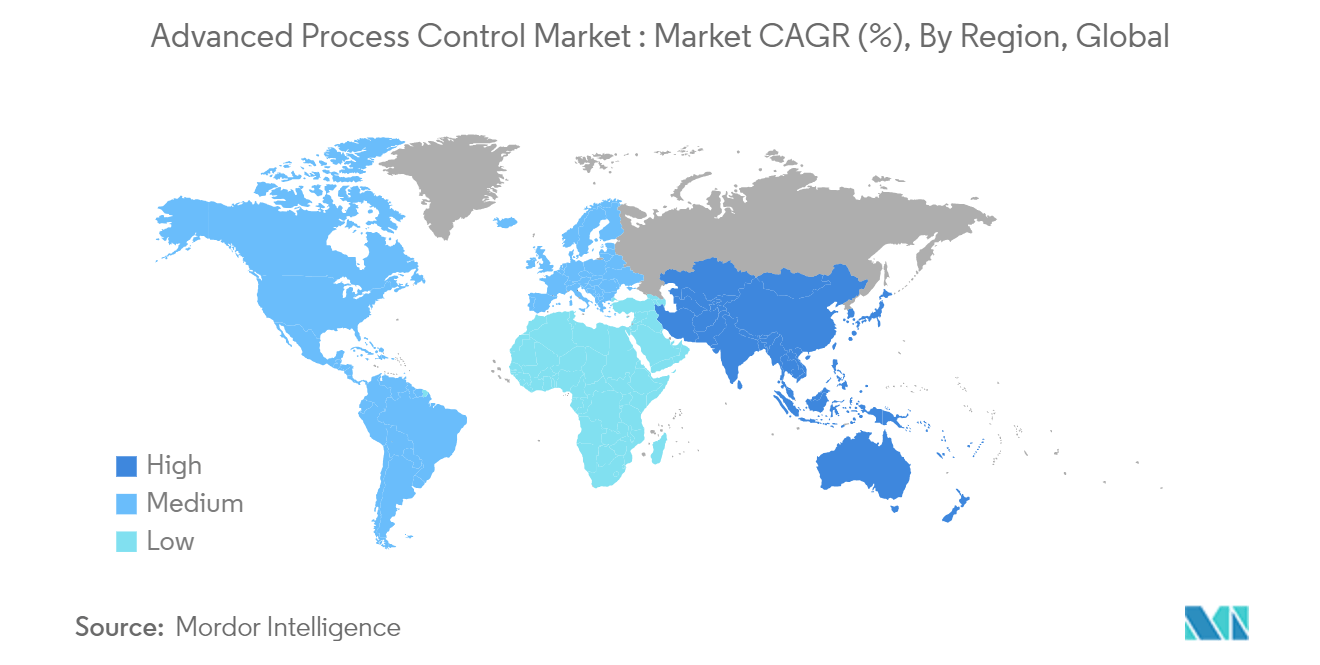Market Trends of Advanced Process Control Industry
Oil and Gas Industry to be the Largest End User
- In the oil and gas sector, production optimization is essential for enhancing output while minimizing costs. APC systems utilize real-time data analytics and predictive modeling to manage production processes more effectively. For instance, in reservoir management, APC can monitor and control parameters such as pressure, temperature, and flow rates. These systems can predict future production trends by analyzing historical data and current conditions and adjust operations accordingly to maximize yield.
- In fields employing Enhanced Oil Recovery (EOR) methods, APC can play a vital role by optimizing injection strategies and monitoring the effectiveness of various recovery techniques. Operators can significantly improve recovery rates and enhance overall production efficiency by dynamically adjusting the parameters based on real-time feedback.
- Data from the Energy Institute highlights the United States as the global leader in crude oil production. In 2023, the United States achieved a daily output of 19.4 million barrels, marking a significant increase from 2010, primarily driven by advancements in unconventional tight oil extraction. Following the United States, Saudi Arabia and Russia secured the second and third positions, producing approximately 11.4 and 11.1 million barrels daily, respectively. It is important to note that oil production encompasses various forms, including crude oil, shale oil, oil sands, and natural gas liquids. The upsurge in oil production is likely to aid the demand for the studied market.
- According to the Energy Institute, in 2023, the majority of oil worldwide was produced in the Middle East, which accounted for around 31.5% of the global output that year. Countries such as United Arab Emirates, Kuwait, Bahrain, and Saudi Arabia are continuously focusing on increasing oil and gas production.
- The United Arab Emirates has made significant investments in bolstering its hydrocarbon production capacity and enhancing its midstream and downstream infrastructure. Furthermore, the country is actively diversifying its production locations. As of early 2023, the UAE's proven crude oil reserves were estimated at a substantial 111 billion barrels, marking an increase from the previouyear's’s 107 billion barrels. The global increase in oil production is anticipated to significantly drive the demand for the studied market.
- APC systems can assist in real-time decision-making during drilling operations. For example, if unexpected geological conditions are detected, the system can automatically adjust drilling parameters or alert operators to take corrective actions. This capability not only enhances efficiency but also reduces the risk of costly drilling incidents and equipment failures.
- According to Baker Hughes, most of the world's's oil rigs are located on land. At the end of 2023, there were 1,337 operational onshore oil rigs and 240 offshore rigs. In 2021, there were 1,309 operational onshore oil rigs. North America leads the world in hosting oil and gas rigs. As of August 2024, the region boasted 781 land rigs and an additional 23 offshore. The robust oil rigs worldwide are likely to offer significant growth to the studied market.

North America is Expected to Hold Significant Market Share
- The North American region is anticipated to hold a significant share of advanced process control with the region's growing new smart factory announcements. Also, the establishment of new power plants, the presence of leading semiconductor manufacturing industries, and the demand for industrial automation are anticipated to augment the market for North American APC systems.
- The United States is the major contributor to the market in the region. As the country is in the middle of an energy transformation, it is witnessing the adoption of advanced technologies across various end-user industries. Technological advancements in hydraulics and drilling fracturing (fracking) of shale formations have driven the growth in oil and gas production.
- The US manufacturing industry has been among the early adopters of these solutions, given the stiff competition from the Chinese manufacturing industry; owing to such factors, the adoption is mature for large-scale adoption, and technology upgrade needs majorly drive demand.
- The growing cybersecurity threats targeting the manufacturing industry present a significant challenge. These challenges, spanning from intellectual property theft, supply chain attacks, and nation-state attacks to equipment sabotage and internal breaches, require an in-depth and multi-layered security approach. It is clear that traditional defenses are insufficient, and a proactive, intelligence-driven strategy is needed to identify and mitigate threats before they escalate.
- The adoption of Industry 4.0 in the global market further emphasized the need for advanced process control systems. The Fourth Industrial Revolution was the focus of last year's World Economic Forum meeting in Davos, and its scope and impact are anticipated to be transformational. This industrial revolution is anticipated to disrupt every industry from various developed countries, changing entire systems of production, management, and governance, including the United States.
- In April 2024, the US Department of the Interior (DOI) granted permits to over 25 GW of renewable energy capacity on public lands, a milestone earmarked initially by the Biden administration for 2025. The DOI approved over 29GW of solar, wind, and geothermal generation capacity on public lands. The Bureau of Land Management (BLM), a body within the DOI, said it is currently processing permits for 66 utility-scale clean energy projects.
- As the generation capacity of renewable energy sources like solar, wind, and hydropower expands, there is a growing need for systems that can optimize their output. APC systems can enhance the efficiency of energy production by continuously adjusting operational parameters to respond to changing environmental conditions, such as fluctuations in sunlight or wind speed. This optimization is crucial for maximizing energy yield and ensuring grid stability.


